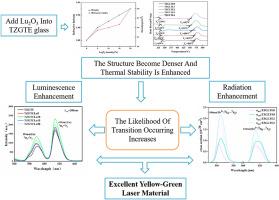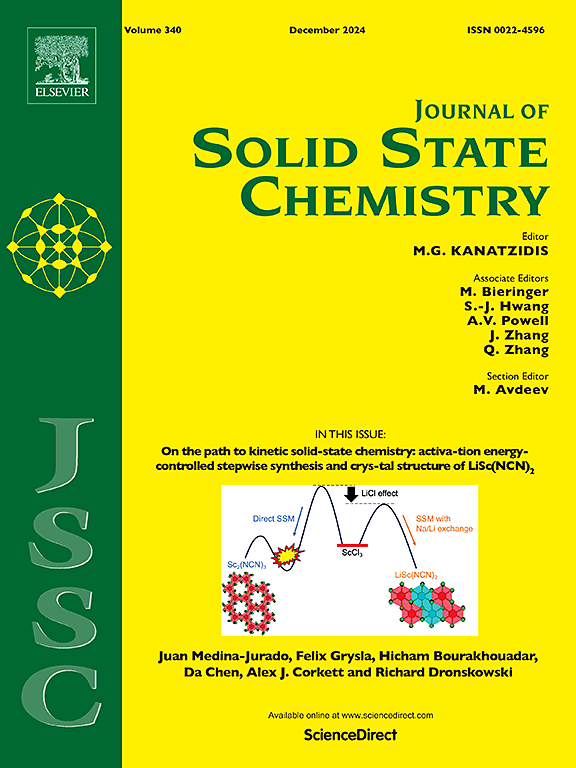Enhancing yellow-green emission in Eu/Tb co-doped tellurite glasses controlled by Lu2O3
IF 3.2
3区 化学
Q2 CHEMISTRY, INORGANIC & NUCLEAR
引用次数: 0
Abstract
In this research, Lu2O3 was incorporated into Eu3+ and Tb3+ co-doped tellurite glasses to enhance structural stability and modify the yellow-green emission. A series of microstructural analyses, including Differential Scanning Calorimetry (DSC), Raman spectroscopy, and density measurements, confirmed that the addition of Lu2O3 causes the long-chain or cyclic Te–O–Te network structure to break, resulting in the formation of more [TeO3], which in turn leads to an increase in non-bridging oxygens (NBO) and lowers the phonon energy of the matrix material. Fluorescence spectral characterization revealed that both green and yellow luminescence intensities peaked when Lu2O3 concentration reached 15 %. Additionally, the Judd-Ofelt theory supports its superior laser performance. With the addition of Lu2O3,The radiative transition probability (Arad), lifetime (τrad), and branching ratio (β) of the excited states of Tb3+ and Eu3+ have all been enhanced. Under the regulation of 15 % Lu2O3, The maximum absorption cross-section of at 544 nm is 1.88 × 10−20 cm2, and the maximum emission cross-section is 2.14 × 10−20 cm2. At 611 nm, the maximum absorption cross-section is 1.05 × 10−20 cm2, and the maximum emission cross-section is 1.44 × 10−20 cm2. The decay curve indicates a fluorescence lifetime enhancement from 0.6 ms to 1 ms with Lu2O3. These results underscore the potential of Lu2O3 modulated Eu3+/Tb3+ co-doped tellurium glass as an effective yellow-green laser gain medium.

在 Lu2O3 的控制下增强 Eu/Tb 共掺碲玻璃的黄绿光发射
在这项研究中,在 Eu3+ 和 Tb3+ 共掺杂的碲玻璃中加入了 Lu2O3,以增强结构稳定性并改变黄绿发射。包括差示扫描量热法(DSC)、拉曼光谱和密度测定在内的一系列微观结构分析证实,加入 Lu2O3 会导致长链或环状 Te-O-Te 网络结构断裂,从而形成更多的 [TeO3],这反过来又会导致非桥接氧(NBO)的增加,并降低基体材料的声子能量。荧光光谱表征显示,当 Lu2O3 浓度达到 15% 时,绿色和黄色发光强度均达到峰值。此外,Judd-Ofelt 理论也支持其卓越的激光性能。加入 Lu2O3 后,Tb3+ 和 Eu3+ 激发态的辐射转变概率(Arad)、寿命(τrad)和分支率(β)都得到了提高。在 15% Lu2O3 的调节下,544 nm 处的最大吸收截面为 1.88 × 10-20 cm2,最大发射截面为 2.14 × 10-20 cm2。在 611 纳米波长处,最大吸收截面为 1.05 × 10-20 平方厘米,最大发射截面为 1.44 × 10-20 平方厘米。衰减曲线表明,Lu2O3 的荧光寿命从 0.6 毫秒延长到 1 毫秒。这些结果凸显了 Lu2O3 调制 Eu3+/Tb3+ 共掺杂碲玻璃作为一种有效的黄绿激光增益介质的潜力。
本文章由计算机程序翻译,如有差异,请以英文原文为准。
求助全文
约1分钟内获得全文
求助全文
来源期刊

Journal of Solid State Chemistry
化学-无机化学与核化学
CiteScore
6.00
自引率
9.10%
发文量
848
审稿时长
25 days
期刊介绍:
Covering major developments in the field of solid state chemistry and related areas such as ceramics and amorphous materials, the Journal of Solid State Chemistry features studies of chemical, structural, thermodynamic, electronic, magnetic, and optical properties and processes in solids.
 求助内容:
求助内容: 应助结果提醒方式:
应助结果提醒方式:


